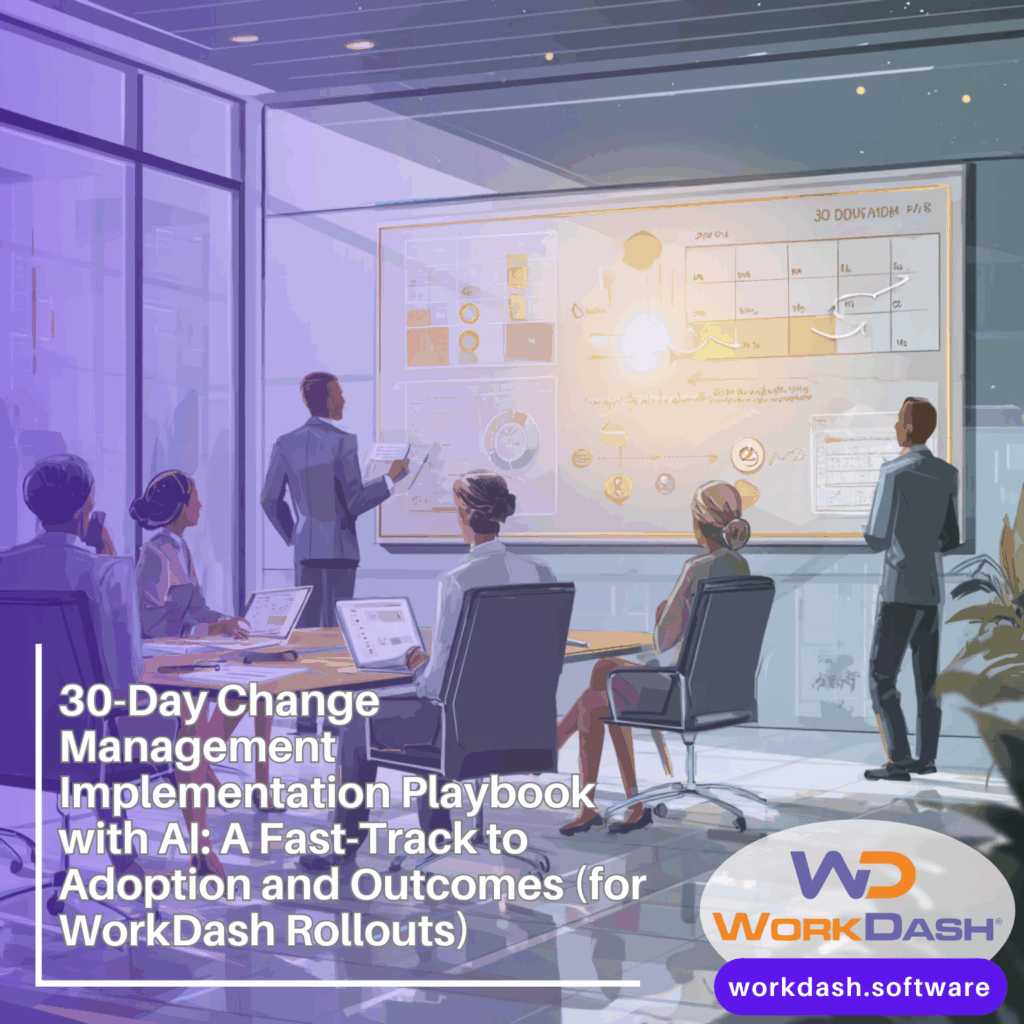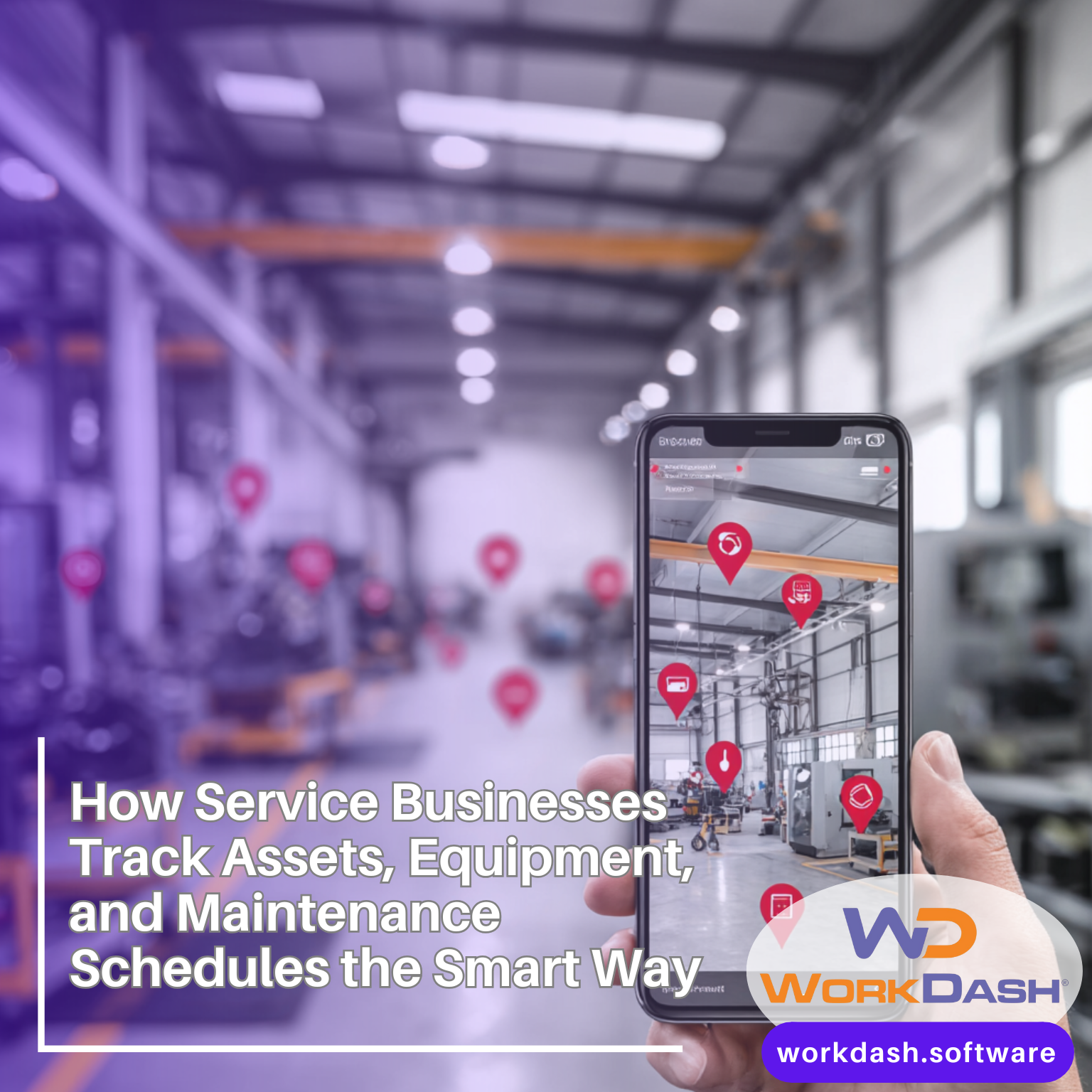Table of Contents
30-Day Change Management Implementation Playbook with AI: A Fast-Track to Adoption and Outcomes (for WorkDash Rollouts)
Summary:
Rolling out an all-in-one platform like WorkDash doesn’t have to take quarters. With the right change management approach, you can deliver a usable new system in 30 days, achieve rapid adoption, and prove value with hard numbers. This practical playbook shows how to plan the implementation, use AI to accelerate training and content, and guide teams through organizational change—from stakeholder buy-in to metric-driven progress. You’ll leave with a clear, reusable template for software implementations that reduces risk and gets people productive faster.
Outline
Why a 30-day change management sprint beats “big-bang” rollouts
What does a successful software implementation look like (and how to prove it)?
Where does AI accelerate adoption—and where does human judgment still matter?
Who owns the change? Stakeholder roles, enablement, and communications playbook
Your 30-day software implementation plan (step-by-step)
How to embed WorkDash in existing workflows without disruption
Measure what matters: metrics, KPIs, dashboard, and the feedback loop
From theory to practice: change management tools, training formats, and a center of excellence
Handling resistance: traditional change management, culture, and middle management
Day-30 and beyond: post-implementation rhythms and continuous improvement
1) Why a 30-day change management sprint beats “big-bang” rollouts
Long, waterfall software implementations can stall momentum. In a 30-day sprint, you define a tight scope, ship a usable slice on day one, and evolve quickly using an agile feedback loop. This drives visible wins and increases adoption because people experience progress, not promises. With a short horizon, leaders can track progress and ensure scope control, while teams experience less uncertainty.
For WorkDash, a 30-day sprint means anchoring a few critical workflows—quote-to-invoice, job scheduling, inventory management, and simple approvals—then layering more functions. This change initiative reduces risk, keeps the business process intact, and proves that effective change management can be fast and humane.
2) What does a successful software implementation look like (and how to prove it)?
A successful software implementation is one where people are using the new system to execute real work and you can show better outcomes with data. Define change KPIs at kickoff: time-to-quote, first-time-fix, invoice cycle time, adoption of new tools, and accuracy rates. Set baseline metrics, then compare weekly.
WorkDash helps ensure measurement by tying operational events to finance and reporting. Because status is real-time, leaders can see the impact of implementation decisions immediately. Your goal is not just “go-live,” but business value within 30 days—clearly evidenced and easy to communicate across the organization.
3) Where does AI accelerate adoption—and where does human judgment still matter?
AI can accelerate adoption in three high-leverage places: just-in-time learning, content generation, and decision support. You can use AI to create quickstart guides, tailor micro-lessons, and summarize policy into job-specific checklists. AI can provide nudges inside a workflow (e.g., suggesting the correct WorkDash template) and draft change notes. But ai is always a copilot, not an autopilot—human judgment validates training and risk decisions.
As you introduce AI into the implementation, be explicit: ai and change management go together when guidance is contextual and respectful of local knowledge. Keep decisions about scope, roles, and process in human hands. Let AI handle repetitive enablement, while people lead transformational change and empathy-driven coaching.
4) Who owns the change? Stakeholder roles, enablement, and communications playbook
Clear ownership is non-negotiable. Assign an executive sponsor to fund and ensure outcomes; a product owner to shape workflow decisions; and change agents in each team to model behaviors. Identify where the change will most impact work (dispatch, finance, store, sales) and tailor enablement to those realities.
Use a simple communications playbook: weekly change announcements, “what’s in it for me” briefs, and a two-way feedback loop that captures blockers. Keep messaging consistent across the organization: why we’re making the change, what’s changing, how to get help, and which metrics we’re using to judge success. This is managing organizational change, not just shipping features.
5) Your 30-day software implementation plan (step-by-step)
Week 1 — Plan & Prove
Draft the business case and scope a minimal viable deployment of WorkDash aligned to two critical workflows.
Build a 1-page project plan with roles, KPIs, and a realistic change management plan.
Map systems and processes to WorkDash modules (jobs, CRM, stock, approvals).
Configure SSO and data import for core entities; outline content management for team docs.
Week 2 — Configure & Train
Configure WorkDash job types, forms, and approvals; set a “template library” for quotes.
Run role-based enablement using AI-generated micro-lessons and checklists tied to workflow.
Dry-run the first end-to-end implementation with a pilot crew; refine existing workflows.
Week 3 — Go-Live & Stabilize
Go live for pilot teams; open the feedback loop; capture bugs and quick wins in real-time.
Publish dashboard tiles for the agreed KPIs; share daily status with the sponsor.
Expand to adjacent groups once the pilot shows steady outcomes.
Week 4 — Expand & Embed
Roll out to remaining users; standardize help routes and a mini center of excellence.
Document post-implementation support, handover, and cadence meetings for continuous improvement.
Summarize results vs. baseline; confirm next month’s backlog.
6) How to embed WorkDash in existing workflows without disruption
To embed a new software platform quickly, map old to new one step at a time. Replace duplicate steps, not entire jobs. For example, convert the quote workflow first, then embed scheduling and approvals. Keep “north star” outcomes—like fewer handoffs and faster invoicing—visible in every discussion.
Treat WorkDash as the operational spine; integrate surrounding systems (ledger, content, CRM) carefully. Respect traditional change wisdom: don’t break what works. But also avoid change without intent—if something is legacy friction, this is your moment to redesign business process for clarity and speed.
7) Measure what matters: metrics, KPIs, dashboard, and the feedback loop
You can’t manage change effectively if you can’t see it. Choose outcome KPIs (e.g., time-to-invoice), behavior metrics (e.g., % jobs created via template), and adoption metrics (e.g., weekly active users). Show them on a WorkDash dashboard so teams can self-correct in real-time. Create a weekly feedback loop to surface friction quickly.
This is where AI shines: use it to summarize chatter into themes, tag top blockers, and draft remediation steps. Then leaders decide. Pair AI summaries with human retrospectives to maintain a holistic view of change outcomes and direct the backlog.
8) From theory to practice: change management tools, training formats, and a center of excellence
Successful programs combine change management tools with fit-for-purpose training. Use a tool like an in-app guide for “click here next” prompts, plus micro-videos and printable job aids. Mix formats—live clinics, office hours, and buddy systems—to empower different learning styles. Keep the feedback loop open and visible.
Stand up a small center of excellence that curates best practices, maintains templates, and coaches teams. This group owns enablement, advises on roadmap, and protects established change management patterns. Over time, it becomes the nucleus for continuous learning and continuous improvement.
9) Handling resistance: traditional change management, culture, and middle management
Resistance is data. Traditional change management teaches us to hear it early and respond with clarity. Use change management strategies that focus on role-specific “what’s in it for me,” highlight early wins, and engage middle management as multipliers. If managers model the new ways of working, behavior change sticks faster.
Where pushback is strong, escalate support: pair coaching with explicit goals, acknowledge workload realities, and reduce cognitive load with smart defaults. Keep change agents visible and trustworthy. When leading change, your job is to reduce fear, ensure safety to learn, and execute change with empathy.
10) Day-30 and beyond: post-implementation rhythms and continuous improvement
By day 30, the heavy lift is done—but the program lives on. Set post-implementation cadences: weekly health checks, monthly roadmap reviews, and quarterly value reports. Refresh training, retire outdated artifacts, and keep content management clean so guidance stays accurate.
Keep AI in the loop for drafting release notes, summarizing feedback loop data, and proposing next steps. But decisions about scope and risk stay with people. Use kpis to track progress and ensure that adoption is expanding across the organization. That’s structured change management: predictable, humane, and value-obsessed.
The 30-Day WorkDash Playbook (Expanded)
1) Prepare (Days 1-7)
Business case: Why WorkDash now? Identify the use case and target outcomes.
Project management: Build your project plan; set roles, risks, and change strategy.
Data readiness: Clean customer, stock, and supplier lists; decide import rules.
Governance: Sponsor + product owner + team leads = strong change triad.
2) Configure (Days 8-14)
Jobs, forms, approvals, and quote templates configured; pilot users invited.
CRM set up for simple pipeline; a second CRM view for service renewals.
Inventory management mapped to jobs; receipts linked to cost centers.
AI-authored quickstart guides; enablement sessions on the calendar.
3) Pilot (Days 15-21)
Live work on two job types; AI nudges inside workflow for tips.
Enterprise application considerations: SSO, permissions, audit trails validated.
KPIs in the dashboard; daily stand-ups; issues triaged same-day.
4) Scale (Days 22-30)
Roll to more users; center of excellence formed; support channels publicized.
Finalize content management; archive legacy docs; standardize naming.
Publish outcomes; confirm phase-2 backlog for continuous improvement.
Special topics for modern change leaders
Agile change
Treat change projects like products: iterate, measure, and improve. Smaller bets minimize disruption and maximize learning.
AI + enablement
Let AI draft learning content, summarize retros, and propose playbooks. Keep curation with humans. Help change leaders by reducing their writing burden and freeing time for coaching.
Risk & compliance
If you operate in regulated contexts, align the WorkDash rollout with policy updates and approvals. Management software evidence (change logs, training records) supports audits elegantly—mention it early.
Cross-functional breadth
WorkDash touches sales, ops, finance, and service. Make content management and inventory management part of your implementation scope so people see end-to-end value fast.
Systems view
Aim for a holistic picture: inputs (training), outputs (quality), outcomes (cycle time, cash), and kpis that prove it.
Frequently asked questions
Q: Can we really roll out an all-in-one in 30 days?
Yes—if scope is tight and ownership is clear. Focus on two core workflows, light integrations, and AI-assisted enablement.
Q: Where does AI help most?
Training content, summarizing obstacles, and real-time prompts in process. Keep decisions human.
Q: What if we have traditional change management fatigue?
Use smaller experiments. Prove value weekly. Make the feedback loop visible and safe.
Q: Do we need a center of excellence?
For sustained results, yes. It keeps templates fresh, curates best practices, and anchors coaching.
Q: How do we handle enterprise application security?
SSO, roles, audit trails, and periodic access reviews—bake them into your software implementation plan from the start.
Tie-in: Why WorkDash fits a fast playbook
WorkDash unifies jobs, stock, CRM, approvals, and ops reporting, so teams don’t bounce between tools. It supports content management for process docs, clean imports for stock and contacts, and simple configuration for quotes, jobs, and approvals. That makes it ideal for a 30-day sprint: fewer integration hurdles, clearer workflow, and immediate business impact. It’s also friendly to post-implementation phases—add modules, automate steps, and expand across the organization as adoption grows.
“Traditional change” vs. this approach (at a glance)
Traditional change management: long design cycles, late training, big-bang go-live.
This playbook: fast scope, AI-assisted enablement, early value, incremental scaling.
Both value planning—but here you embed learning in the work and let people experience progress now.
One-page template (use it today)
Goal: Reduce quote-to-invoice by 30% in 30 days.
Scope: Two job types; quotes, scheduling, invoicing, stock issue, simple approvals.
Roles: Sponsor (Ops), Product Owner (Service), Tech Lead (Admin), change agents (Dispatch & Finance).
KPIs/metrics: Cycle time, first-time-fix, % jobs using template, weekly active users.
Cadence: Daily stand-up; weekly show-and-tell; open feedback loop; phase-2 backlog.
Risks: Over-customization; data quality; competing priorities.
Mitigation: Tight scope; data clean room; sponsor-led prioritization.
Bullet-Point Summary — The Playbook in Plain English
Lead with change management that’s iterative, empathetic, and focused on outcomes.
Scope small: two critical workflows in 30 days; prove value on day one and expand.
Use AI to generate training, summarize blockers, and guide users—keep human judgment on decisions.
Name owners: sponsor, product owner, change agents, and pilot leads; align stakeholder expectations.
Build a crisp software implementation plan with KPIs/metrics and a visible dashboard.
Embed WorkDash in existing workflows first; redesign where pain is highest.
Run a visible feedback loop; publish wins; iterate weekly for continuous improvement.
Stand up a center of excellence to curate best practices, templates, and coaching.
Equip managers to handle resistance with clarity, empathy, and proof of value.
Treat post-implementation as the real engine of value: keep improving processes and outcomes.
With this 30-day playbook, you’ll ensure your WorkDash implementation lands quickly, teams feel supported, and leaders can see tangible results in real-time—the essence of proven change management that sticks.





